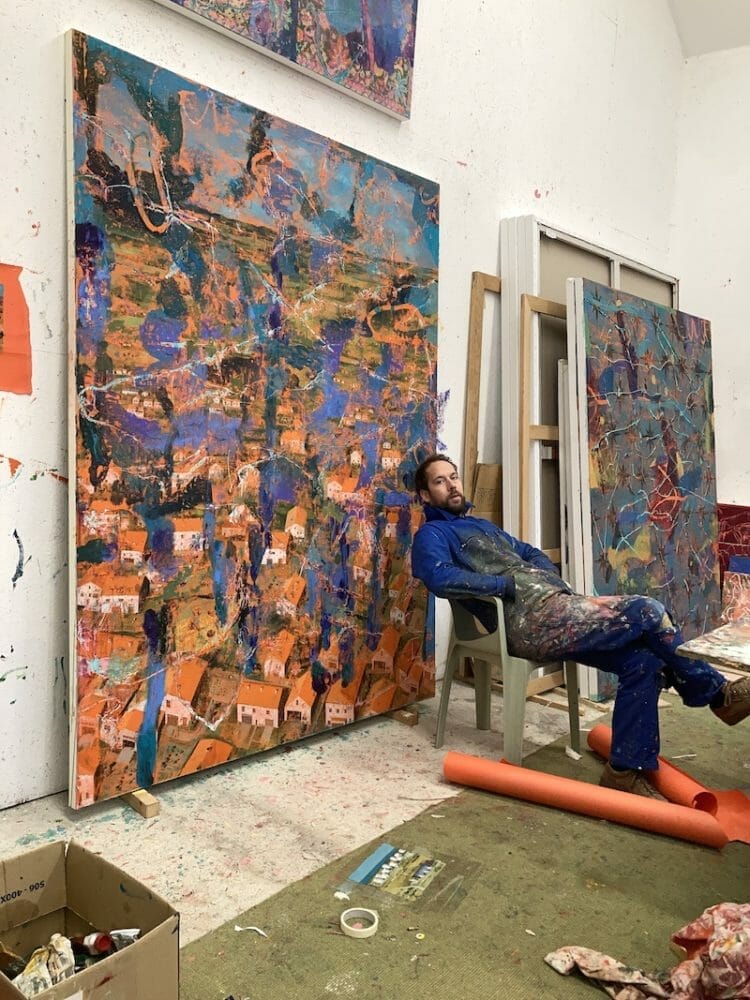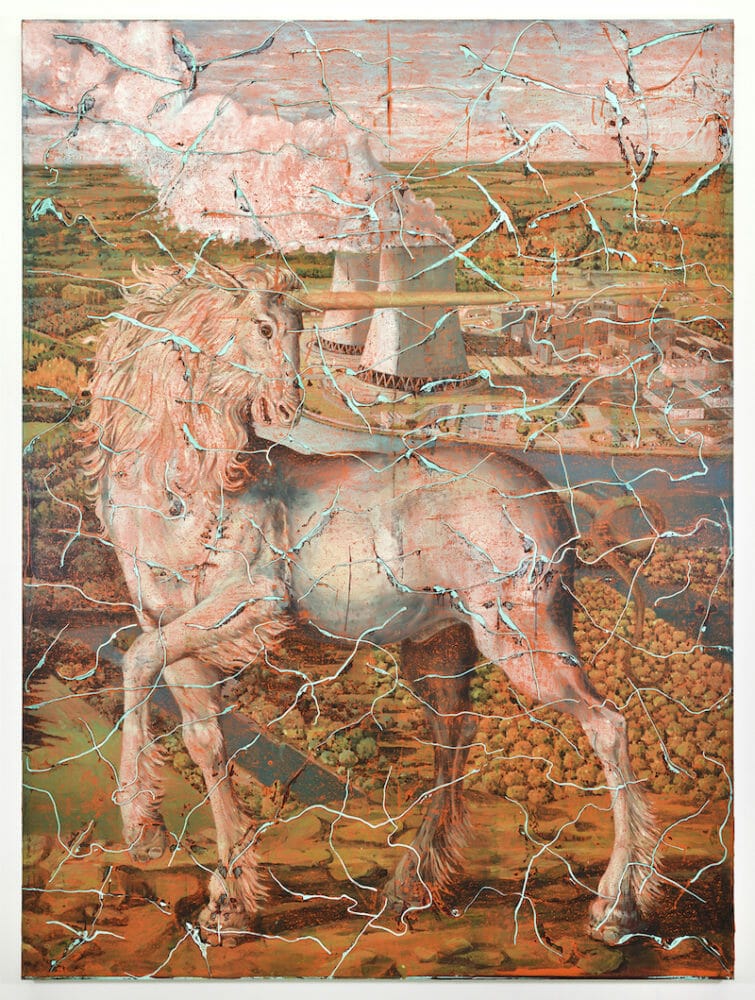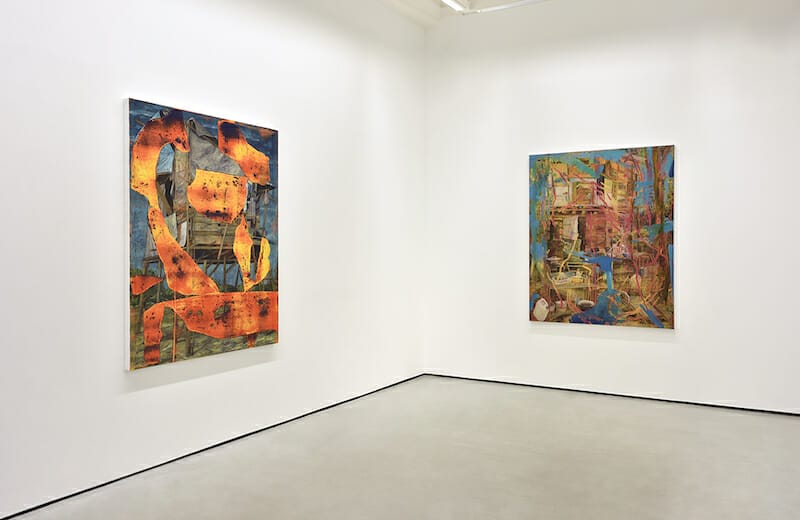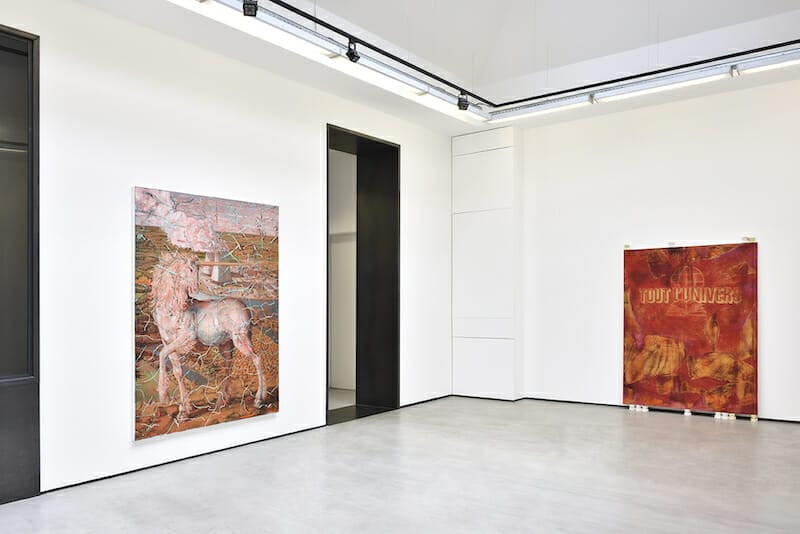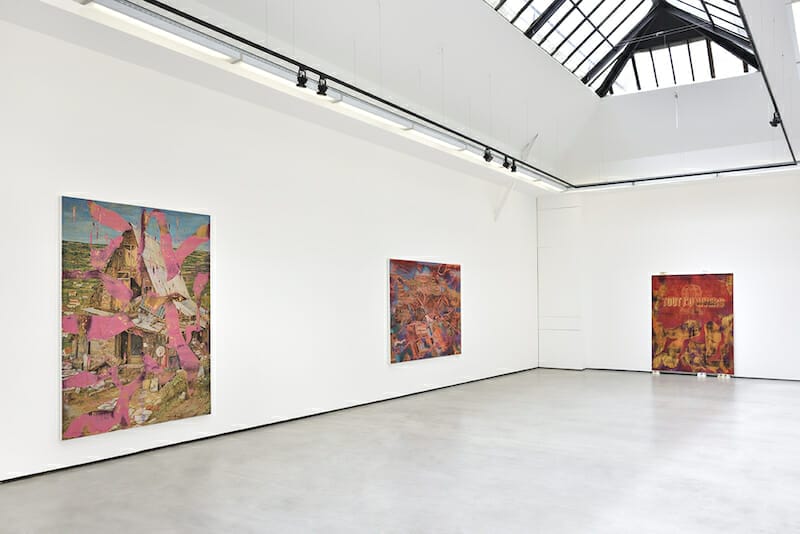Editor's Note: The following interview was conducted in French, and translated by Picture This Post's trilingual editor, Mingyuan Dong. The original interview in French can be found below the English translation.
“…this exhibition is intended as an ode to the real world, just as painting is an ode to the physicality of dreams.…”
So says artist Julien des Monstiers about his recent series of works entitled Bêtaverse. The exhibition opened on 11 June, 2022 at Christophe Gaillard Gallery in Paris, France, and will close on 30 July 2022. Bêtaverse builds on the idea of a meta world. In this creation, Des Monstiers aims to present an other world – a world with connections from the past, a world more real than the real world: full of intuitions, autonomy, and complexities to be rediscovered.
Des Monstiers explains that he has experimented with a variety of techniques and styles in his artist journey. In his works, you can find elements of geometry, repetition, color contrast, and rhythm. With the medium of oil, he produces both figurative and abstract pieces, sometimes combining other classical materials. In this sixth exhibition at Christophe Gaillard Gallery, Des Monstiers exhibits only figurative paintings for the first time.
Here, the artist Julien Monstier (JM) speaks with Picture This Post (PTP) about his works in exhibition Bêtaverse and the inspirations for his art.
(PTP) Does Bêtaverse convey an alternative reality?
(JM) This Exhibition embodies the idea that the Painting has always had something revolutionary, even in the digital era. The painting itself is already an alternative language. Sometimes, the promise of future progress makes us forget that we have to work with the real, the present, and the physicality of the world. Thus, I did not create an alternative reality. I simply highlighted that reality already exists.
How do you physically convey this idea in your work?
Painting is a beautiful idea in the sense that it renews itself continuously… The painters have to do it differently, but with the same ingredients. I work with oil on canvas and other classical mediums. The way I use the material of painting is rather complex: I have my own rules, my own processes. The canvas is textured, and then, the picture is painted. People think that I often ruin my paintings in the process, while on the contrary, I paint them like that.
Instead of being drawn to the subject of painting, I am always more interested in the elements of picture-making: the format, the gestures, the textures, and the mediums. With the medium of painting, I do not really create another world.
Instead, I reveal the world in which we live with my own vocabulary.
How does this Bêtaverse exhibit fit into your journey as an artist?
For a long time, I painted figurative works in a very conventional way. Around 2012, I started to paint on another surface other than canvas, and repaint the pictures I painted on the canvas. I have a big table in the studio where I paint my pictures with the most precision. Then, I place a big plastic film on the fresh painting, on which the medium sticks and transfers. Finally, I pull up the plastic film, place it on the surface of the painting, and the picture transfers itself for a second time. It is a bit complicated, but very simple at the same time. It brings about the impression that the painting was not done by hand, even though it is in this case.
In this exhibition, Bêtaverse, I used my new techniques creating big abstract traces on the canvases. For the first time, I only exhibit figurative paintings, even though I usually also make big abstract paintings.
What are some others’ reactions to your works?
In general, the first questions that people ask me are regarding the painting technique. The paintings seem to be simple, but when people look at them closer, they realize that something does not make sense. They are not able to know how and in what chronological order the paintings were painted.
The second reaction is often an appreciation of the colors. I have worked a lot with decorative patterns coming from an artisan background: with painted paper, carpets, tile patterns, etc. It does not bother me at all that the paintings are attractive aesthetically because I know that the decorative elements are not the only things that make them up. They have to be there before all the good paintings are made.
What elements from the physical and the cultural world did you want to include in your works?
The triptych with the same size (210 cm x 160 cm) represents the cover of the encyclopedia ALL UNIVERSE (TOUT L’UNIVERS).
Before the Internet, this encyclopedia was available in almost every French household. It was a collection with tens of volumes, in which we could find all the History of knowledge. It was a bit like the Internet before the Internet… The texts in the book were accompanied by illustrations: photos and the drawings that I always looked at when I was young. I used to spend hours and hours copying the illustrations. This exhibition speaks to everyone, but it speaks to those of my generation particularly, who clearly remember the world before the Internet.
When I started to think about this exhibition Bêtaverse, I immediately told myself that I would make a triptych representing the red cover of this encyclopedia. These canvases are almost abstract paintings, except that we see the golden typography ALL UNIVERSE (TOUR L’UNIVERS) exactly as how it appeared on the books that I had at home. I consider this triptych as classical Vanitas. For this reason, they are placed on teeth. The triptych is a kind of homage to the physical world with a slightly ironic view of the past. Most importantly, I do not want to say that the world was better before. My idea is more of an homage to the physical world, and to not make it seem that it has never existed.
Additionally, in my works, I used images of cabins built by people who made the decision to live autonomously. These constructions are very interesting to paint because their architectural structures are very original. And also, the constructions show that in the real, physical world, people choose to isolate themselves from the system and their conditions of existence, without using technological skills or even taking refuge in a virtual reality. The real is more interesting and profound than everything.
For more information, visit the Christophe Gaillard Gallery website.
Original interview in French:
(PTP) Est-ce que Bêtaverse parle d'une réalité alternative?
(JM) L’idée de cette Exposition était d’assumer que la Peinture a toujours eu quelque chose de révolutionnaire, même à l’heure du numérique. La peinture est déjà un langage alternatif. La promesse d’un progrès futur fait parfois oublier que nous avons à travailler avec le réel, le présent, et la physicalité du monde. Je n’ai donc pas créé de réalité alternative, je souligne simplement qu’elle est déjà là.
Comment est-ce que vous communiquez cette idée physiquement dans vos œuvres?
La peinture est une belle idée dans le sens qu’elle se renouvelle sans arrêt… Les peintres doivent faire différemment mais avec les mêmes ingrédients. Je travaille avec de la peinture à l’huile sur toile, et avec d’autres matériaux classiques. J’ai une façon d’utiliser la matière qui est assez complexe: j’ai mes propres règles, mon propre processus. Les peintures sont texturées puis ensuite l'image est peinte. On pense souvent que j'abîme mes tableaux alors que c’est complètement l’inverse, je les peins comme ça.
Je me suis toujours plus intéressé à la façon dont on faisait un tableau: le format, les gestes, les textures et la matière, plus que de savoir quoi peindre. Avec la matière de la peinture, je ne crée pas vraiment un autre monde, disons que je révèle celui dans lequel nous vivons mais avec mon propre vocabulaire.
Comment est-ce que l’exposition de Bêtaverse s’intègre à votre parcours comme artiste?
Pendant longtemps, j’ai peins des images figuratives, de façon assez conventionnelle. Puis, vers 2012 j’ai commencé à peindre sur une autre surface que la toile et je reportais l’image peinte sur le tableau. J’ai une grande table à l'atelier, sur laquelle je peins mes images, de façon très précise. Ensuite, je dépose sur la peinture fraîche un grand film plastique sur lequel la matière vient se coller et se transférer. Enfin je retire le film plastique et le dépose à la surface du tableau et l'image vient se transférer une seconde fois. C’est un peu compliqué et très simple à la fois, cela donne l’impression que le tableau n’a pas été fait à la main alors que c’est bien sur le cas. Dans cette exposition Bêtaverse, j’ai utilisé de nouvelles techniques pour créer de grandes traces abstraites sur les toiles. Pour la première fois, je ne montre que des tableaux figuratifs alors qu’habituellement je fais aussi de grandes toiles abstraites.
Quelles sont les réactions des autres envers vos œuvres?
Généralement les premières questions que l'on me pose sont liées à la technique que j'utilise pour peindre. Les toiles ont l'air simples mais lorsqu’on les regarde de près on se rend compte que quelque chose ne va pas, on n’arrive pas a savoir comment et dans quelle chronologie a été peinte la toile. La seconde réaction est souvent d’apprécier les couleurs. J’ai beaucoup travaillé avec des motifs décoratifs venant de l’artisanat, des papiers peints, des tapis, des motifs de carrelage etc. Ça ne me dérange pas du tout que les tableaux soient séduisants, car je sais que ce n’est pas la seule chose qui les compose, il faut que ce soit avant tout de bons tableaux.
Quels sont les éléments du monde physique et culturel que vous voulez intégrer dans vos œuvres?
Dans cette exposition, je présente 3 pièces qui sont posées sur des dentiers en plâtre. Ce sont trois toiles de la même taille (210 cm x 160 cm), qui représentent la couverture de l’encyclopédie TOUT L’UNIVERS. Avant internet, cette encyclopédie était dans presque tous les foyers français. C’était un recueil d’une dizaine de volumes dans lequel on pouvait trouver toute l'Histoire de la connaissance. C’était un peu internet avant internet… Les informations étaient illustrées par des photos et des dessins que j’ai beaucoup regardés étant jeune. J’ai passé des heures et des heures à recopier ces illustrations. Cette exposition s’adresse à tout le monde, mais particulièrement aux gens de ma génération qui se rappellent très bien du monde avant internet.
Quand j’ai commencé à penser à cette exposition Bêtaverse, je me suis très rapidement dit que je ferai trois-toiles représentant la couverture rouge de cette encyclopédie. Ces toiles sont des peintures presque abstraites, mais on voit la typographie TOUT L’UNIVERS en dorée exactement comme elle était sur les livres que j’avais à la maison. J’ai pensé ces trois tableaux comme des Vanités classiques, c’est pour ça qu' elles sont disposées sur des dents. La trois-toiles est une sorte d’hommage au monde physique avec un regard un peu ironique sur le passé. Je ne veux surtout pas dire que le monde était mieux avant, mon idée est plus de rendre hommage au monde physique et ne pas faire semblant qu’il n’a pas existé.
Par ailleurs, dans mes œuvres, j’ai utilisé des images de cabanes fabriquées par des gens qui ont décidé de vivre en autonomie. Ces constructions sont très intéressantes à peindre puisque leurs architectures sont très originales, mais aussi pour montrer que dans le monde réel et physique, des personnes font le choix de s’isoler du système et décident de leurs conditions d’existences, sans utiliser de moyens technologiques, et sans même se réfugier dans une réalité virtuelle. Le réel est plus intéressant et profond que tout.
Photos: Rebecca Fanuele

About the Author: Mingyuan Dong
Ming has lived in China, the United States, and France. She speaks the languages of all three of these countries, as well as German. With these tongues, Ming enjoys traveling, visiting art museums around the world, and discussing all kinds of art with fellow art enthusiasts.
Ming grew up studying drawing in studios. Today, Ming spends most of her time making art, or studying the arts. She especially enjoys making works about linguistics, the natural environment, and living situations.

